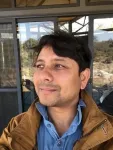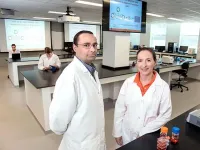An atom chip interferometer that could detect quantum gravity
2021-06-04
(Press-News.org) Physicists in Israel have created a quantum interferometer on an atom chip. This device can be used to explore the fundamentals of quantum theory by studying the interference pattern between two beams of atoms. University of Groningen physicist, Anupam Mazumdar, describes how the device could be adapted to use mesoscopic particles instead of atoms. This modification would allow for expanded applications. A description of the device, and theoretical considerations concerning its application by Mazumdar, were published on 28 May in the journal Science Advances.
The device which scientists from the Ben-Gurion University of the Negev created is a so-called Stern Gerlach Interferometer, which was first proposed one hundred years ago by German physicists Otto Stern and Walter Gerlach. Their original aim of creating an interferometer with freely propagating atoms exposed to gradients from macroscopic magnets has not been practically realized until now. 'Such experiments have been done using photons, but never with atoms', explains Anupam Mazumdar, Professor of Theoretical Physics at the University of Groningen and one of the co-authors of the article in Science Advances.
Diamonds
The Israeli scientists, led by Professor Ron Folman, created an interferometer on an atom chip, which can confine and/or manipulate atoms. A beam of rubidium atoms is levitated over the chip using magnets. Magnetic gradients are used to split the beam according to the spin values of the individual atoms. Spin is a magnetic moment that can have two values, either up or down. The spin-up and spin-down atoms are separated by a magnetic gradient. Subsequently, the two divergent beams are brought together again and recombined. The spin values are then measured, and an interference pattern is formed. Spin is a quantum phenomenon, and throughout this interferometer, the opposing spins are entangled. This makes the interferometer sensitive to other quantum phenomena.
Mazumdar was not involved in the construction of the chip, but he contributed theoretical insights to the paper. Together with a number of his colleagues, he previously proposed an experiment to determine whether gravity is in fact a quantum phenomenon using entangled mesoscopic objects, namely tiny diamonds that can be brought in a state of quantum superposition. 'It would be possible to use these diamonds instead of the rubidium atoms on this interferometer', he explains. However, this process would be highly complex as the device, which is currently operated at room temperature, would need to be cooled down to around 1 Kelvin for the mesoscopic experiment.
Free fall
If this is realized, two of these atom chips could free fall together (to neutralize external gravity), so that any interaction occurring between them would depend on the gravitational pull between the two chips. Mazumdar and his colleagues aim to determine whether quantum entanglement of the pair occurs during free fall, which would mean that the force of gravity between the diamonds is indeed a quantum phenomenon. Another application of this experiment is the detection of gravity waves; their deformation of space-time should be visible in the interference pattern.
The actual implementation of this experiment is still a long way off, but Mazumdar is very excited now that the interferometer has been created. 'It is already [a] quantum sensor, although we still have to work out exactly what it can detect. The experiment is like the first steps of a baby - now, we have to guide it to reach maturity.'
INFORMATION:
Reference: Yair Margalit, Or Dobkowski, Zhifan Zhou, Omer Amit, Yonathan Japha, Samuel Moukouri, Daniel Rohrlich, Anupam Mazumdar, Sougato Bose, Carsten Henkel and Ron Folman: Realization of a complete Stern-Gerlach interferometer: Toward a test of quantum gravity Science Advances, online 28 May 2021.
[Attachments] See images for this press release:

ELSE PRESS RELEASES FROM THIS DATE:
2021-06-04
Researchers in Lund, Copenhagen and Norwich have shown that harmful mutations present in the DNA play an important - yet neglected - role in the conservation and translocation programs of threatened species.
"Many species are threatened by extinction, both locally and globally. For example, we have lost about ten vertebrate species in Sweden in the last century. However, all these species occur elsewhere in Europe, which means that they could be reintroduced into Sweden. Our computer simulations show how we could theoretically maximize the success of such reestablishments", says Bengt Hansson, biologist at Lund University.
In a new study published in Science, the researchers investigated which individuals might be most suited for translocation ...
2021-06-04
The COVID-19 pandemic forced instructors to adapt their courses for online learning. Laboratory courses were particularly difficult due to lack of access to specialized equipment for remote learners. To overcome this challenge, researchers from the University of Illinois Urbana-Champaign designed a laboratory exercise to teach students how to use micropipettes, through remote learning, using at-home kits.
Micropipettes are common--and essential--laboratory instruments and are used in several fields including molecular biology, microbiology, and biochemistry. They are used to accurately transfer very small volumes of liquid. To teach students how to use these instruments, the researchers developed kits, costing $135 per student, that were a fraction ...
2021-06-04
COLUMBUS, Ohio - New research suggests that African American families living in public housing are a "hidden population" when it comes to national suicide prevention efforts.
The study showed 11% of Black teens and young adults living in a mid-Atlantic public housing development reported that in the previous 12 months, they had made a plan to die by suicide.
The finding fits with what previous research has shown: that African American youths are the fastest-growing group engaging in suicidal behavior and dying by suicide, and have the highest suicide death rate increase among any other racial or ethnic minority group, ...
2021-06-04
How plants cope with stress factors has already been broadly researched. Yet what happens when a plant is confronted with two stressors simultaneously? A research team working with Simon Haberstroh and Prof. Dr. Christiane Werner of the Chair of Ecosystem Physiology at the Institute of Forest Sciences and Natural Resources (UNR) of the University of Freiburg is investigating this. Together with colleagues from the Forest Research Center of the School of Agriculture of the University of Lisbon in Portugal and the Institute of Meteorology and Climate Research at ...
2021-06-04
Highlights
Among adults with kidney failure undergoing hemodialysis in New York City, Black and Hispanic patients were more likely to develop symptomatic COVID-19 than White patients.
Neighborhood-level social vulnerability factors were associated with COVID-19 incidence among White patients, but these factors did not explain racial/ethnic disparities.
Washington, DC (June 1, 2021) -- In an analysis of patients on hemodialysis in New York City, there were substantial racial/ethnic disparities in COVID-19 rates that were not explained by neighborhood social vulnerability. The findings appear in an upcoming ...
2021-06-04
LOWELL, Mass. - A UMass Lowell geologist is among the researchers who have discovered a new type of manmade quasicrystal created by the first test blast of an atomic bomb.
The formation holds promise as a new material that could one day help repair bone, insulate heat or convert heat to electricity, among other uses, according to UMass Lowell Prof. G. Nelson Eby, a member of the university's Environmental, Earth and Atmospheric Sciences Department.
Eby is a member of the research team that identified the quasicrystal substance inside samples of trinitite they examined that were collected from the debris of the first atomic bomb detonated by the U.S. Army on July 16, 1945 in the New Mexico desert. Also known as atomic rock, trinitite ...
2021-06-04
New York, NY, June 3, 2021 -- A study of over 59,000 Icelandic adolescents by a team of Icelandic and North American behavioral and social scientists found that COVID-19 has had a significant, detrimental impact on adolescent mental health, especially in girls. The study is the first to investigate and document age- and gender-specific changes in adolescent mental health problems and substance use during the COVID-19 pandemic, while accounting for upward trends that were appearing before the pandemic. The findings are published in The Lancet Psychiatry.
The study found that negative mental health outcomes were disproportionately reported by girls and older adolescents (13-18-year-olds), compared to same-age peers prior to the pandemic. At the same ...
2021-06-04
A first encounter with the dengue virus typically causes very mild symptoms; however, a subsequent infection is a different story. For a small proportion of people who are reinfected, the virus can cause severe symptomatic disease, which is often life-threatening.
"The main hypothesis for some time has been that antibodies generated the first time around, instead of providing protection against disease, can actually exacerbate it," says Stylianos Bournazos, research assistant professor at Rockefeller. "But even in secondary infection, we see a wide range of symptoms--so ...
2021-06-04
As India continues to be ravaged by the pandemic, a Swansea University academic is investigating how green tea could give rise to a drug capable of tackling Covid-19.
Dr Suresh Mohankumar carried out the research with colleagues in India during his time at JSS College of Pharmacy, JSS Academy of Higher Education and Research in Ooty prior to taking up his current role at Swansea University Medical School.
He said: "Nature's oldest pharmacy has always been a treasure of potential novel drugs and we questioned if any of these compounds could assist us in battling the Covid-19 pandemic?
"We screened and sorted a library of natural compounds already know to be active against other coronaviruses using an artificial ...
2021-06-04
Hospital price transparency is intended to help inform patients about the cost of services and procedures before they receive them. Since Jan. 1, 2021, hospitals in the U.S. have been required by The Centers for Medicare and Medicaid Services (CMS) to provide pricing information online about items and services. A team of researchers from Brigham and Women's Hospital and Massachusetts Eye and Ear leveraged the newly available data to analyze price transparency and price variation for the treatment of thyroid cancer. The team found that both transparency and price varied widely, with only half of the cancer centers studied reporting disclosure ...
LAST 30 PRESS RELEASES:
[Press-News.org] An atom chip interferometer that could detect quantum gravity

